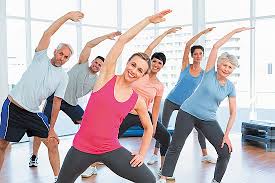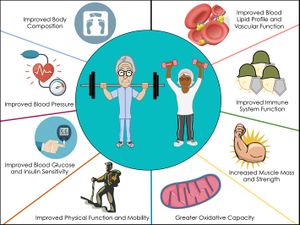Health and fitness are essential for improving the quality of life in communities. They enhance physical and mental well-being, foster social connections, and contribute to a healthier economy.
Health and fitness play a vital role in the well-being of individuals and the overall community. They contribute to better living conditions, improve quality of life, and enhance social interactions.
This article explores the importance of health and fitness within communities, how they affect individuals, and what can be done to promote a healthier society.
The Significance of Health and Fitness:

Enhancing Physical Health:
Maintaining good health and fitness helps prevent chronic diseases such as heart disease, diabetes, and obesity. Regular exercise and a balanced diet strengthen the body, improve immune function, and enhance overall physical health. When community members prioritize their health, they experience fewer health issues, which can lead to lower healthcare costs for everyone.
Improving Mental Health:
Physical activity is not only good for the body but also for the mind. Exercise releases endorphins, which are hormones that help reduce stress and anxiety. This mental boost can improve mood and overall mental well-being. In communities where fitness is prioritized, members may experience lower rates of depression and anxiety, fostering a healthier social environment.
Also read: Welch Allyn Pocket Scope Which Tip Is Fit – Choosing Pocket Scope Tips!
Promoting Healthy Lifestyles:
Communities that emphasize health and fitness encourage residents to adopt healthier lifestyles. This can include eating nutritious foods, exercising regularly, and avoiding harmful habits like smoking and excessive drinking. When people see their peers engaging in healthy behaviors, they are more likely to follow suit, creating a culture of health and wellness.
The Social Benefits of Health and Fitness:
Building Community Bonds:
Participating in health and fitness activities can bring people together. Group workouts, sports leagues, and community fitness events encourage social interaction and create a sense of belonging. These activities help break down barriers and foster friendships among diverse community members.
Encouraging Inclusivity:
Health and fitness initiatives can promote inclusivity by providing opportunities for people of all ages, abilities, and backgrounds to participate. Community centers and organizations can offer various programs tailored to different fitness levels, ensuring everyone feels welcome and included.
Fostering a Sense of Purpose:
Engaging in health and fitness activities can provide individuals with a sense of purpose. Whether it’s training for a marathon or participating in a local sports team, having goals related to fitness encourages people to stay active and motivated. This sense of purpose can positively impact community morale.
Economic Impact of Health and Fitness:

Reducing Healthcare Costs:
When communities prioritize health and fitness, they can significantly reduce healthcare costs. Healthy individuals require less medical attention, leading to lower insurance premiums and fewer healthcare expenses for the community. This financial relief allows resources to be allocated to other essential services.
Boosting Local Economies:
Health and fitness-related businesses, such as gyms, health food stores, and wellness centers, can boost the local economy. As more individuals invest in their health, these businesses thrive, creating jobs and increasing revenue for the community. Moreover, hosting health and fitness events can attract visitors and generate additional income.
Improving Productivity:
Healthy individuals tend to be more productive at work and in their daily lives. Regular exercise increases energy levels, sharpens focus, and enhances overall performance. A community that values health and fitness may experience increased productivity, benefiting local businesses and the economy.
How to Promote Health and Fitness in the Community:
Organizing Community Events:
Local governments and organizations can host events such as health fairs, fun runs, and fitness challenges to encourage community participation. These events raise awareness about health and fitness while providing opportunities for residents to get involved.
Providing Access to Resources:
Ensuring that community members have access to resources like parks, gyms, and healthy food options is essential. Local governments can invest in recreational facilities, walking trails, and farmers’ markets to make healthy choices more accessible.
Implementing Educational Programs:
Offering workshops and classes on nutrition, exercise, and mental health can help educate community members about the importance of health and fitness. Schools, community centers, and local organizations can provide resources and knowledge to empower individuals to make informed choices.
Also read: Hks Super Air Filter Type 16 Honda Fit 2015-2020 – Performance Boost Honda Fit!
The Role of Schools in Promoting Health and Fitness:
Encouraging Physical Education:
Schools play a crucial role in promoting health and fitness among children and adolescents. Incorporating regular physical education classes into the curriculum helps instill healthy habits from a young age. This early exposure encourages students to prioritize their health throughout their lives.
Providing Healthy Meal Options:
Schools can also promote health by offering nutritious meal options in cafeterias. By providing healthy food choices, schools can help students develop a taste for nutritious foods and educate them about healthy eating habits.
Involving Parents and Communities:
Involving parents and the community in school health initiatives can strengthen the message of health and fitness. Schools can organize family fitness nights, health fairs, and workshops to engage parents and encourage them to model healthy behaviors at home.
Overcoming Barriers to Health and Fitness:

Addressing Time Constraints:
Many individuals struggle to find time for fitness in their busy lives. Communities can help by offering flexible workout schedules, on-site fitness classes at workplaces, and promoting short, effective workouts that can fit into anyone’s day.
Combating Financial Barriers:
The cost of gym memberships, healthy foods, and fitness classes can be a barrier for some community members. Offering free or low-cost fitness programs and providing access to affordable, healthy food options can help overcome these financial challenges.
Building a Supportive Environment:
Creating a supportive environment for health and fitness is crucial. Communities can foster this environment by promoting local fitness groups, encouraging residents to share their fitness journeys, and celebrating health-related achievements within the community.
FAQ’S
1. What does health and fitness mean for a community?
Health and fitness in a community means that people are physically active and take care of their bodies. It includes regular exercise, good nutrition, and mental well-being.
2. Why is physical health important for everyone?
Physical health helps prevent diseases like diabetes and heart problems. When people are healthy, they feel better, have more energy, and can enjoy life more.
3. How does fitness improve mental health?
Exercise releases chemicals in the brain that make us feel happy. It can reduce stress, anxiety, and depression, helping people feel better mentally.
4. Can being fit help reduce healthcare costs?
Yes! When people are healthy and fit, they need fewer doctor visits and medical treatments. This can lower healthcare costs for everyone in the community.
5. How does fitness bring people together?
Fitness activities, like group workouts or sports teams, help people meet and make friends. This creates a sense of belonging and strengthens community ties.
6. Why should schools promote health and fitness?
Schools can teach kids about healthy habits early on. When children learn about fitness and nutrition, they are more likely to continue these habits as adults.
7. What are some ways to promote health in the community?
Communities can organize events like fun runs, health fairs, and fitness classes. They can also provide parks and resources for people to stay active.
Conclusion
In conclusion, health and fitness are crucial for improving individual well-being and the overall quality of life in communities. They foster better physical and mental health, strengthen social connections, and support local economies. Prioritizing health and fitness creates a positive culture that benefits everyone.